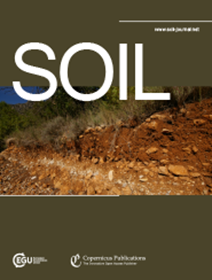Formation of mineral-associated organic matter via rock weathering: an experimental test for the organo-metallic glue hypothesis
IF 4.3
2区 农林科学
Q1 SOIL SCIENCE
引用次数: 0
Abstract
Abstract. Mineral-associated organic matter (MAOM), representing the dominant form of relatively stable C in soil, contains high physicochemical heterogeneity. The co-localization of organic matter (OM) with reactive aluminum (Al) and iron (Fe) phases in various MAOM fractions—across a range of natural and cultivated soils from five soil orders—has led to the “organo-metallic glue” hypothesis. The hypothesis proposes that coprecipitates formed between mineral-derived metals and microbially processed OM act as a binding agent, promoting the formation of stable microaggregates and thereby enhancing soil OM persistence. However, the formation mechanism remains unclear as the observed associations reflect multiple soil processes. We thus designed a simple laboratory experiment to test if the supply of metals and metalloids through rock weathering controls MAOM formation and if the OM-to-metal ratio of the material formed is consistent with complexation, sorptive association, or their mixture (i.e., coprecipitates). Two end-member igneous rocks (granite and basalt) crushed to have 38–75 µm size and, additionally, 20–38 µm size for basalt, as well as river sand (100–300 µm) as control were mixed with leaf compost (powdered to 100–250 µm) as single OM source. The mineral-OM mixtures were incubated aerobically at 30 oC with the natural soil microbial community and subjected to 8 wet-and-dry cycles using artificial rainwater (pH 4.73) over a 55-day experiment. The mixtures were then fractionated by density to examine the formation of meso-density, organo-mineral aggregates (1.8–2.4 g cm–3: MF) by distinguishing it from the compost-dominant low-density fraction (< 1.8 g cm–3: LF) and high-density fraction (>2.4 g cm–3: HF) consisting of the crushed rock. The MF formation assessed as C content was 1.49 ± 0.06 mg C g–1 rock (fine basalt), 1.04 ± 0.08 (coarse basalt), and 0.62 ± 0.06 (granite) over the 55 days, while the net MF mass increase was detected only in fine basalt due to the presence of meso-density materials in the crushed rock (< 7 % by mass). Faster chemical weathering of the fine basalt was indicated by a significant increase in extractable Fe and Al phases, largely in MF, and the highest leaching of Fe and base cations (esp. Na and Ca). The organo-mineral aggregates formed in the fine basalt treatment had the C-to-metal (Fe+Al) ratio of 0.36 ± 0.01 (molar basis), consistent with organo-metal coprecipitation. Further analysis focusing on the two basalt treatments revealed a significant decline in C:N ratios by 23–25 units and enrichment of δ13C and δ15N by 0.9–1.2 ‰ and 0.6 ‰, respectively, in MFs compared to LFs, indicating a strong contribution of microbial N-containing compounds to the MAOM formation. While microbial community composition differed among the treatments, no significant difference was found in qPCR-based bacterial number or species richness. Microscopic analyses using SEM and STXM confirmed the presence of shaking-resistant microaggregates and co-localization of C, Fe, and Al in MF from selected MF samples. Together, our results strongly supported the organo-metallic glue hypothesis and provided laboratory evidence of basalt-induced MAOM formation as well as some insights into early pedogenesis and organo-mineral interactions when applying crushed rock to soils.岩石风化过程中与矿物有关的有机物的形成:有机-金属胶假说的实验检验
摘要。矿物伴生有机质(MAOM)是土壤中相对稳定的碳的主要形式,具有较高的物理化学异质性。有机物质(OM)与活性铝(Al)和铁(Fe)相在各种MAOM组分中的共定位-跨越了五个土壤目的自然和栽培土壤-导致了“有机-金属胶”假说。该假设认为,矿物来源的金属与微生物处理的OM之间形成的共沉淀作为一种结合剂,促进稳定微团聚体的形成,从而增强土壤OM的持久性。然而,由于观察到的关联反映了多种土壤过程,形成机制尚不清楚。因此,我们设计了一个简单的实验室实验,以测试通过岩石风化作用的金属和类金属的供应是否控制了MAOM的形成,以及形成的材料的om -metal比例是否与络合作用、吸附结合或它们的混合物(即共沉淀)相一致。两个端元火成岩(花岗岩和玄武岩)被粉碎成38-75微米的尺寸,另外,玄武岩的尺寸为20-38微米,以及河砂(100-300微米)作为对照,与树叶堆肥(粉末至100-250微米)混合作为单一OM源。在30℃的条件下,与天然土壤微生物群落一起培养矿物质- om混合物,并在55天的实验中使用人工雨水(pH为4.73)进行8次干湿循环。然后根据密度对混合物进行分馏,通过将其与堆肥占主导地位的低密度组分(<;1.8 g cm-3: LF)和由碎石组成的高密度组分(>2.4 g cm-3: HF)。在55天内,MF地层的C含量分别为1.49±0.06 mg(细玄武岩)、1.04±0.08 mg(粗玄武岩)和0.62±0.06 mg(花岗岩),而净MF质量仅在细玄武岩中检测到增加,这是由于岩石破碎中存在中密度物质(<;7%(质量)。细粒玄武岩的化学风化速度加快,主要表现在可提取的Fe和Al相显著增加,且铁和碱阳离子(尤其是Na和Ca)的浸出量最高。细粒玄武岩处理形成的有机矿物团聚体的c -金属(Fe+Al)比为0.36±0.01(摩尔基),符合有机-金属共沉淀。对两种玄武岩处理的进一步分析表明,与低碳层相比,中碳层的C:N比值显著下降了23-25个单位,δ13C和δ15N分别富集了0.9-1.2‰和0.6‰,表明微生物含氮化合物对MAOM的形成有重要贡献。微生物群落组成在不同处理间存在差异,但基于qpcr的细菌数量和物种丰富度无显著差异。使用SEM和STXM进行的显微分析证实,从选定的MF样品中,MF中存在抗振动微聚集体和C、Fe和Al的共定位。总之,我们的研究结果有力地支持了有机金属胶假说,并提供了玄武岩诱导MAOM形成的实验室证据,以及在将碎岩应用于土壤时对早期成土作用和有机矿物相互作用的一些见解。
本文章由计算机程序翻译,如有差异,请以英文原文为准。
求助全文
约1分钟内获得全文
求助全文
来源期刊

Soil
Agricultural and Biological Sciences-Soil Science
CiteScore
10.80
自引率
2.90%
发文量
44
审稿时长
30 weeks
期刊介绍:
SOIL is an international scientific journal dedicated to the publication and discussion of high-quality research in the field of soil system sciences.
SOIL is at the interface between the atmosphere, lithosphere, hydrosphere, and biosphere. SOIL publishes scientific research that contributes to understanding the soil system and its interaction with humans and the entire Earth system. The scope of the journal includes all topics that fall within the study of soil science as a discipline, with an emphasis on studies that integrate soil science with other sciences (hydrology, agronomy, socio-economics, health sciences, atmospheric sciences, etc.).
 求助内容:
求助内容: 应助结果提醒方式:
应助结果提醒方式:


